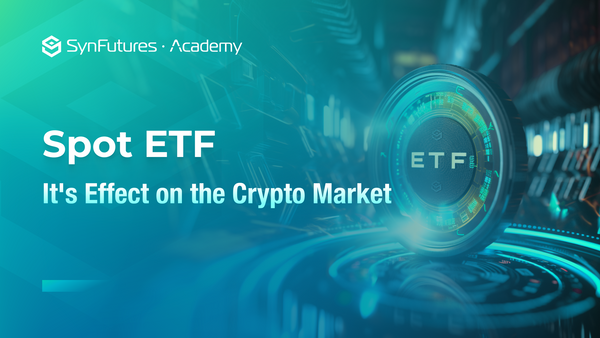An In-depth View of the Crypto Derivatives Market
The crypto derivatives market today is huge with hundreds of billions worth of trades happening every single day. Its volume is even bigger than the spot market, which allows users to either hedge their positions or make a leveraged trade without worrying about liquidity. Its massive size, however, obscures the fact that this market is very young and it’s practically in its infancy when compared to the traditional derivative market. Let’s take a deeper look at this emerging field and understand its history, concept, and future.
History
Even as early as 2011, a few entrepreneurial Bitcoiners started the first Bitcoin futures market called ICBIT. The site acted as the central intermediary allowing traders to buy and sell futures contracts and the trades were all settled in BTC. Although it offered a pioneering service, ICBIT could not gain mass adoption for a variety of reasons, not the least of which was the fact that Bitcoin was extremely volatile in those days.
In 2014, the famous (or infamous) BitMEX was founded by Arthur Hayes, Ben Delo, and Samuel Reed. In 2016, the exchange launched its Perpetual Swap product which revolutionized the crypto derivative ecosystem by offering extreme leverage options that went as high as 125 times. BitMEX soon became the number one derivatives platform, reaching over $1 trillion in yearly trading volume at its peak. However, the platform soon ran into legal trouble in the US when the founders were charged with violating the Banking Secrecy Act.
Despite what happened to BitMEX, the crypto derivative genie was already out of the bottle, and there was no putting it back. The next major milestone in the history of crypto derivatives came in December 2017 when the CME group launched its Bitcoin derivatives which marked the beginning of crypto derivatives trading in the traditional financial markets.
Basic Concepts in Crypto Derivatives
New entrants to the derivatives market may find themselves overwhelmed by the number of technical phrases and jargon used. Open Interest, leverage, strike price, and market cap, for example, might sound like gibberish to the average person and could scare them away from entering the derivatives field.
While at first glance these terms might seem complicated, they are all easy to understand with a little time and effort and can provide the user with a wealth of knowledge to make successful trades.
So, let’s go through some of the commonly used phrases that we are likely to see on any derivatives trading platform.
Underlying Asset
This one is simple. It refers to the asset that the derivative is based on. For Bitcoin futures, Bitcoin is the underlying asset. Its price moves according to the price of Bitcoin. Similarly, for ETH futures, Ethereum is the underlying asset.
Leverage
A mechanism through which traders can take a bigger position than their current capital. However, this also comes with the additional risk of liquidation where traders could lose their entire capital. The amount of leverage varies from asset to asset, and it can range from a safe 2x leverage to as high as 100x leverage. A 2x leverage allows a trader to take a $2,000 position with $1,000 of capital and the position will only get liquidated if the price moves by 50%. A 100x leverage would allow a trader to take a $100,000 position with the same $1,000 but here the position could get liquidated if the price moves by even 1% against the trader. All traders should understand that leverage is a double-edged sword that should only be used with extreme caution.
Futures
A type of derivative product that allows users to buy or sell the underlying asset at a future date. Both the buyer and the seller are obligated to buy and sell the product on the expiry date. In traditional markets, this derivative is very useful for investors to protect themselves from price volatility. However, in the crypto ecosystem, futures are primarily used to gain more leverage. It gives traders the opportunity to earn more money while taking larger risks. Another feature unique to crypto is a special type of Futures called Perpetual contracts.
Perpetual Contract
Almost identical to a Futures contract with one main difference: it does not expire, unlike its traditional counterpart. This means users can bet on the future price of the crypto without the time constraint.
Open Interest (OI)
Refers to the number of outstanding contracts that have not been settled so far. For example, Adam wants to sell s to sell one BTC Future contract and places the sell order, and Brad buys that contract. Now, the open interest on BTC futures is 1. Next Catherine wants to sell 3 more BTC contracts and Brad, who is confident the price will go up, decides to buy all three as well. Now, the total number of OI increases to 4. A few days later, the price of Bitcoin moves up by 5% forcing Adam to buy back his futures contract at a loss from Brad. This decreases the OI to 3 as Adam has closed his position and exited the market.
Open Interest is often used to judge the strength of the underlying asset. The below table shows how:
Price | Volume | Open Interest | Mood of the Market |
Rising | Increasing | Increasing | Bullish |
Rising | Decreasing | Decreasing | Bullish Trend Weakening |
Declining | Increasing | Increasing | Bearish |
Declining | Decreasing | Decreasing | Bearish Trend Weakening |
Valuing the underlying asset
All the above-mentioned metrics and terms are specifically related to the derivatives market. However, the price of any derivative is ultimately decided by the price of the underlying asset. So, every derivative trader needs to understand some basic metrics that impact the price of the underlying asset. Let’s look at a few of those below:
Market Capitalization
Commonly referred to as a market cap, this is the most basic metric that’s used to judge the value of any crypto project. It’s simply calculated by multiplying the number of coins by the value of each coin and is like how the value of companies in the stock market is calculated. However, unlike the stock market where the number of stocks doesn’t change daily, the crypto market sees a constant change in the number of coins either because of inflation or burning. So, the market cap of crypto is further divided into two categories:
Current market cap: Just multiply the number of coins that are currently in circulation with the price of the token to get this number.
Fully diluted market cap: This is obtained by multiplying the current price by the maximum number of coins that will ever be produced. This is a subjective metric as no one really knows what the price of the coin would be when all the coins are created, but it’s still useful in giving a ballpark figure to judge the total value of a project.
Total Value Locked (TVL)
It is a key metric to look at when calculating the worth of a DeFi project. It refers to the total user funds locked up in the project either in staking pools, liquidity pools, or lending pools. Generally, a higher TVL value means more users trust the project, which is a good sign. However, it should be kept in mind that TVL numbers change rapidly for new projects. A project with great TVL this week could lose almost all of it next week. So, it's important to keep a close and constant watch on the TVL numbers to get a better understanding of the project's real worth.
The Future
In traditional finance, the derivatives market has earned an important place. There are countless hedge funds whose entire business model depends on derivatives trades. According to a recent report from Deutsche Borse Group, the traditional derivatives market has grown by 24% per year over 25 years. In Europe, the derivatives trade accounts for 20% of wholesale financial sector revenue. It’s possible that we can see similar impressive growth in the crypto derivatives market in the coming future as well.
The crypto derivatives market currently stands at around $3 trillion in volume according to an article in the financial post and accounts for 57% of the monthly crypto volume, according to a report from Jumpcrypto. Currently, the major stumbling block for the crypto derivatives industry is regulatory uncertainty. If we start to see positive crypto regulations, then the crypto derivative market should witness a stellar growth rate that outshines the crypto spot market.
Discover SynFutures' Crypto Derivatives products: www.synfutures.com/.
Disclaimer: SynFutures Academy does not guarantee the reliability of the site content and shall not be held liable for any errors, omissions, or inaccuracies. The opinions and views expressed in any SynFutures Academy article are solely those of the author(s) and do not reflect the opinions of SynFutures. The SynFutures Academy articles are for educational purposes or information only. SynFutures Academy has no relationship to the projects mentioned in the articles, and there is no endorsement for these projects. The information provided on the site does not constitute an endorsement of any of the products and services discussed or investment, financial, or trading advice. A qualified professional should be consulted prior to making financial decisions.




